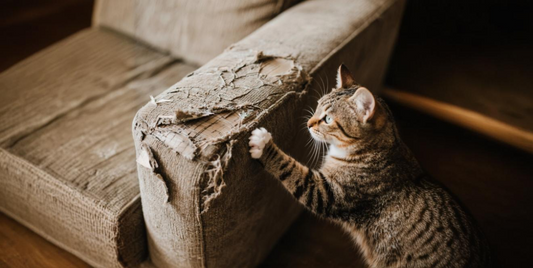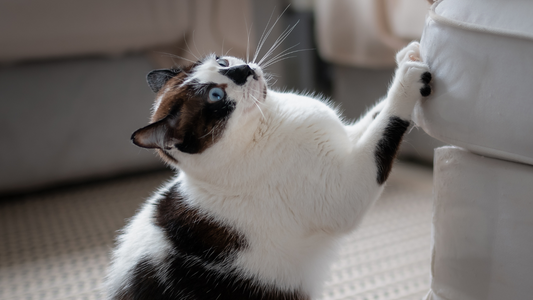Scratching Isn’t the Problem — Misdirection Is
Your cat isn’t scratching the furniture to be bad — they’re doing it because they haven’t found a better alternative yet. Scratching is natural and necessary for feline wellness, but where they scratch is something you can guide. The key? Understanding your cat’s preferred scratching style and giving them an option they like even more than your couch. If you want a quick primer on what each style says about your cat, start with Why Cats Scratch (and What Their Scratching Style Says About Them).
Step 1: Identify Why and Where Your Cat Scratches
Observe your cat’s habits:
- Scratching vertical surfaces like couch arms or doors — these are stretchers who need a tall, stable post. The Hide & Scratch Vertical Cat Scratcher Box is ideal for upright stretchers.
- Clawing carpets or rugs — these cats often prefer horizontal scratchers with satisfying floor contact. Try the Hide & Scratch Extra Large Cat Scratcher Box for a roomy, low-profile option.
- Targeting multiple surfaces — a mix of incline and flat options can satisfy different moods and angles.
Also look at when they scratch:
- Right after waking: Often part of a natural stretch reflex.
- When you leave or return: Can be a form of territory marking.
- Random bursts: May be play-driven or a stress release.
These clues help you match both the type and placement of the scratcher to the behavior you want to redirect. For a fuller breakdown of styles and what they mean, see Why Cats Scratch.
Step 2: Choose a Scratcher That Fits Their Style
- Vertical Scratchers: Great for tall stretchers and confident territory markers — the Hide & Scratch Vertical Cat Scratcher Box offers a sturdy, upright option.
- Horizontal Pads: Perfect for laid-back loungers or senior cats — the Hide & Scratch Extra Large Cat Scratcher Box provides plenty of flat space.
- Incline Scratchers: For high-energy or mixed-style scratchers who like varied angles.
- Lounge-Style Boxes: For cats who want to scratch and then hide or nap in the same space.
Need help comparing shapes and textures? Product-specific guidance lives in Choosing the Right Cat Scratcher — Flat, Vertical, or Lounge Style?
Step 3: Place It Where They’re Already Scratching
Location matters more than you think. Place scratchers:
- Directly next to the problem area (e.g., by the couch they love to scratch).
- Near favorite nap spots (cats stretch and scratch when they wake).
- Along common paths or near windows (for marking and engagement).
Once they’re reliably using it, you can slowly move it to a more preferred location.
Step 4: Make the New Option More Appealing
Help your cat fall in love with their scratcher:
- Sprinkle catnip on the surface.
- Use toys or treats to draw them in.
- Praise and reward them when they use it.
- Mimic scratching with your fingers to demonstrate.
At the same time, block access to furniture if needed — try double-sided tape, blankets, or a temporary barrier.
Step 5: Be Consistent and Patient
Changing habits takes time. Some cats switch quickly, others need a few weeks. The more consistent you are with placement, encouragement, and removing access to “no-no zones,” the faster your cat will learn.
Conclusion: Stop Furniture Scratching by Working With Your Cat’s Instincts
The best way to stop your cat from scratching the furniture isn’t punishment — it’s redirection. By identifying your cat’s scratching style and offering a well-placed, appealing alternative, you honor their natural instincts while protecting your home. Whether your cat is a vertical stretcher, a horizontal pad fan, or an all-in-one lounger, choosing the right scratcher (and placing it wisely) is the key to lasting behavior change. For a refresher on comparing styles and materials, revisit Choosing the Right Cat Scratcher.





